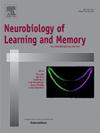情景记忆检索-再激活海马印染细胞的结构突触特征。
IF 1.8
4区 心理学
Q3 BEHAVIORAL SCIENCES
引用次数: 0
摘要
学习增强了海马印痕细胞突触的连通性,这对印痕的再激活和对自然线索的回忆至关重要。记忆检索只涉及学习激活集合的一个子集,这表明再激活和非再激活细胞的突触连接特征存在潜在差异。我们在中性情境探索(CE)或厌恶情境恐惧条件反射(CFC)后72 h,研究了近期记忆检索后突触结构连接模式的差异。使用eGRASP(增强的绿色荧光蛋白(GFP)在突触伙伴间重组)和病毒trap(激活群体中的靶向重组)的组合将CA3突触标记到CA1印迹细胞上,我们研究了重新激活和未重新激活群体之间脊柱密度、簇和形态的差异。在此过程中,我们开发了一个用于重建和分析树突和棘的管道,将嵌套数据结构考虑在内。我们的数据表明,CA1印迹细胞突触的数量、分布和形态与再激活状态、上下文价态或两者之间存在相互作用。尽管缺乏脊柱密度的差异,与未激活的对应体或编码中性环境的印迹细胞相比,编码厌恶环境的重新激活印迹细胞的特征是形成脊柱簇的概率更高,脊柱类型特征更动态。总之,我们的数据表明,在印痕细化过程中,学习激活的集合在结构突触连接方面经历了不同的轨迹。本文章由计算机程序翻译,如有差异,请以英文原文为准。
Structural synaptic signatures of contextual memory retrieval-reactivated hippocampal engram cells
Learning enhances hippocampal engram cell synaptic connectivity which is crucial for engram reactivation and recall to natural cues. Memory retrieval engages only a subset of the learning-activated ensemble, indicating potential differences in synaptic connectivity signatures of reactivated and non-reactivated cells. We probed these differences in structural synaptic connectivity patterns after recent memory retrieval, 72 h after either neutral Context Exploration (CE) or aversive Contextual Fear Conditioning (CFC). Using a combination of eGRASP (enhanced green fluorescent protein (GFP) reconstitution across synaptic partners) and viral-TRAP (targeted recombination in activated populations) to label CA3 synapses onto CA1 engram cells, we investigated differences in spine density, clusters, and morphology between the reactivated and non-reactivated population of the learning ensemble. In doing so, we developed a pipeline for reconstruction and analysis of dendrites and spines, taking nested data structure into account. Our data demonstrate an interplay between reactivation status, context valence or both factors on the number, distribution, and morphology of CA1 engram cell synapses. Despite a lack of differences in spine density, reactivated engram cells encoding an aversive context were characterised by a higher probability of forming spine clusters and a more dynamic spine type signature compared to their non-reactivated counterparts or engram cells encoding a neutral context. Together, our data indicate that the learning-activated ensemble undergoes different trajectories in structural synaptic connectivity during engram refinement.
求助全文
通过发布文献求助,成功后即可免费获取论文全文。
去求助
来源期刊
CiteScore
5.10
自引率
7.40%
发文量
77
审稿时长
12.6 weeks
期刊介绍:
Neurobiology of Learning and Memory publishes articles examining the neurobiological mechanisms underlying learning and memory at all levels of analysis ranging from molecular biology to synaptic and neural plasticity and behavior. We are especially interested in manuscripts that examine the neural circuits and molecular mechanisms underlying learning, memory and plasticity in both experimental animals and human subjects.

 求助内容:
求助内容: 应助结果提醒方式:
应助结果提醒方式:


